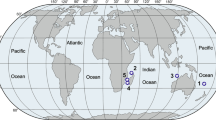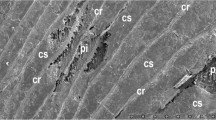Abstract
Attempts to understand the intricacies of biosilicification in sponges are hampered by difficulties in isolating and culturing their sclerocytes, which are specialized cells that wander at low density within the sponge body, and which are considered as being solely responsible for the secretion of siliceous skeletal structures (spicules). By investigating the homosclerophorid Corticium candelabrum, traditionally included in the class Demospongiae, we show that two abundant cell types of the epithelia (pinacocytes), in addition to sclerocytes, contain spicules intracellularly. The small size of these intracellular spicules, together with the ultrastructure of their silica layers, indicates that their silicification is unfinished and supports the idea that they are produced “in situ” by the epithelial cells rather than being incorporated from the intercellular mesohyl. The origin of small spicules that also occur (though rarely) within the nucleus of sclerocytes and the cytoplasm of choanocytes is more uncertain. Not only the location, but also the structure of spicules are unconventional in this sponge. Cross-sectioned spicules show a subcircular axial filament externally enveloped by a silica layer, followed by two concentric extra-axial organic layers, each being in turn surrounded by a silica ring. We interpret this structural pattern as the result of a distinctive three-step process, consisting of an initial (axial) silicification wave around the axial filament and two subsequent (extra-axial) silicification waves. These findings indicate that the cellular mechanisms of spicule production vary across sponges and reveal the need for a careful re-examination of the hitherto monophyletic state attributed to biosilicification within the phylum Porifera.












Similar content being viewed by others
References
Aizenberg J, Weaver JC, Thanawala MS, Sundar VC, Morse DE, Fratzl P (2005) Skeleton of Euplectella sp.: structural hierarchy from nanoscale to the macroscale. Science 309:275–278
Baccetti B, Gaino E, Sarà M (1986) A sponge with acrosome: Oscarella lobularis. J Ultrastruct Mol Struct Res 94:195–198
Borchiellini C, Chombard C, Manuel M, Alivon E, Vacelet J, Boury-Esnault N (2004) Molecular phylogeny of Demospongiae: implications for classification and scenarios of character evolution. Mol Phylogenet Evol 32:823–837
Boury-Esnault N, Ereskovsky A, Bézac C, Tokina D (2003) Larval development in the Homoscleromorpha (Porifera ; Demospongiae). Invert Biol 122:187–202
Boute N, Exposito JY, Boury-Esnault N, Vacelet J, Noro N, Miyazaki K, Yoshizato K, Garrone R (1996) Type IV collagen in sponges, the missing link in basement membrane ubiquity. Biol Cell 88:37–44
Bütschli O (1901) Einige Beobachtungen über Kiesel- und Kalknadeln von Spongien. Z Wissensch Zool 69:235–286
Cha JN, Shimizu K, Zhou Y, Christiansen SC, Chmelka BF, Stucky GD, Morse DE (1999) Silicatein filaments and subunits from a marine sponge direct the polymerization of silica and silicones in vitro. Proc Natl Acad Sci USA 96:361–365
Connes R (1977) Contribution à l’étude de la gemmulogenèse chez la Démosponge marine Suberites domuncula (Olivi) Nardo. Archs Zool Exp Gén 118:391–407
Custodio MR, Hajdu E, Muricy G (2002) In vivo study of microsclere formation in sponges of the genus Mycale (Demospongiae, Poecilosclerida). Zoomorphology 121:203–211
Dendy A (1912) The tetraxonid sponge spicule: a study in evolution. Acta Zool (Stockh) 2:95–152
Garrone R (1969) Une formation paracristalline d’ARN intranucléaire dans les choanocytes de l’Eponge Haliclona rosea O.S. (Démosponge, Haploscléride). C R Acad Sci Paris 269:2219–2221
Garrone R, Simpson TL, Pottu-Boumendil J (1981) Ultrastructure and deposition of silica in sponges. In: Simpson TL, Volcani BE (eds) Silicon and siliceous structures in biological systems. Springer, New York, pp 495–525
Imsiecke G, Müller WE (1995) Unusual presence and intracellular storage of silica crystals in the freshwater sponges Ephydatia muelleri and Spongilla lacustris (Porifera: Spongillidae). Cell Mol Biol 41:827–832
Jørgensen CB (1944) On the spicule formation of Spongilla lacustris (L). I. The dependance of the spicule formation on the content of dissolved and solid silicic acid of the medium. D Klg Danske Vidensk Selskab Biol Medd 19:1–45
Ledger PW (1976) Aspects of the secretion and structure of calcareous sponge spicules. PhD thesis. University College, N. Wales
Lévi C, Barton JL, Guillemet C, Le Bras E, Lehuede P (1989) A remarkably strong natural glassy rod: the anchoring spicule of the monorhaphis sponge. J Mat Sci Lett 8:337–339
Maldonado M (2004) Choanoflagellates, choanocytes, and animal multicellularity. Invert Biol 123:231–242
Maldonado M, Carmona MC, Uriz MJ, Cruzado A (1999) Decline in Mesozoic reef-building sponges explained by silicon limitation. Nature 401:785–788
Maldonado M, Carmona MC, Velásquez Z, Puig A, Cruzado A, López A, Young CM (2005) Siliceous sponges as a silicon sink: an overlooked aspect of the benthopelagic coupling in the marine silicon cycle. Limnol Oceanogr 50:799–809
Minchin EA (1909) Sponge spicules. A summary of present knowledge. Ergeb Fortschr Zool 2:171–274
Müller WEG, Rothenberger M, Boreiko A, Tremel W, Reiber A, Schröder HC (2005) Formation of siliceous spicules in the marine demosponge Suberites domuncula. Cell Tissue Res 321:285–297
Müller WEG, Belikov SI, Tremel W, Perry CC, Gieskes WWC, Boreiko A, Schröder HC (2006) Siliceous spicules in marine demosponges (example Suberites domuncula. Micron 37:107–120
Muricy G, Díaz MC (2002) Order Homosclerophorida Dendy, 1905, Family Plakinidae Schulze, 1880. In: Hooper JNA, Van Soest RWM (eds) Systema Porifera. A guide to the classification of sponges. Kluwer Academic/Plenum, New York, pp 71–82
Riesgo A, Maldonado M, Durfort, M (2007) Dynamics of gametogenesis, embryogenesis, and larval release in a Mediterranean homosclerophorid demosponge. J Mar Freshwater Res (in press)
Schröder HC, Perovic-Ottstadt S, Wiens M, Batel R, Müller IM, Müller WEG (2004) Differentiation capacity of epithelial cells in the sponge Suberites domuncula. Cell Tissue Res 316:271–280
Schwab DW, Shore RE (1971) Mechanisms of internal stratification of siliceous sponge spicules. Nature 232:501–502
Shimizu K, Cha JN, Stucky GD, Morse DE (1998) Silicatein alpha: cathepsin L-like protein in sponge biosilica. Proc Natl Acad Sci USA 95:6234–6238
Simpson TL (1984) The cell biology of sponges. Springer, New York
Uriz MJ, Turon X, Becerro MA (2000) Silica deposition in Demosponges: spiculogenesis in Crambe crambe. Cell Tissue Res 301:299–309
Wang X, Lavrov DV (2007) Mitochondrial genome of the homoscleromorph Oscarella carmela (Porifera, Demospongiae) reveals unexpected complexity in the common ancestor of sponges and other animals. Mol Biol Evol (in press)
Weaver JC, Morse DE (2003) Molecular biology of demosponge axial filaments and their roles in biosilicification. Micro Res Tech 62:356–367
Weaver JC, Pietrasanta LI, Hedin N, Chmelka BF, Hansma PK, Morse DE (2003) Nanostructural features of demosponge biosilica. J Struct Biol 144:271–281
Acknowledgements
The authors thank Almudena García and Nuria Cortadellas (Electron Microscopy Unit, University of Barcelona) for their valuable help in processing TEM samples and three anonymous reviewers for their constructive comments.
Author information
Authors and Affiliations
Corresponding author
Additional information
This work was supported by grants from the Cellular and Molecular Program (BMC2002-01228) and the Natural Resources Program (CTM2005-05366-MAR) of the Spanish Ministry of Sciences and Education (MEC).
Rights and permissions
About this article
Cite this article
Maldonado, M., Riesgo, A. Intra-epithelial spicules in a homosclerophorid sponge. Cell Tissue Res 328, 639–650 (2007). https://doi.org/10.1007/s00441-007-0385-7
Received:
Accepted:
Published:
Issue Date:
DOI: https://doi.org/10.1007/s00441-007-0385-7




